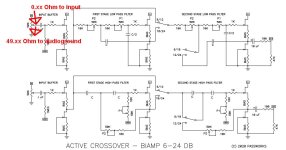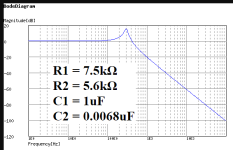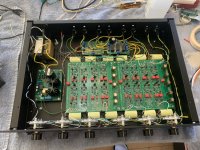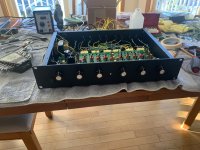Any thoughts on converting the second stage into an allpass filter for phase alignment on a offset speaker?
It could be very useful for a fixed horn cabinet configuration to delay the woofer thats crossed over around 1k with a 8“ offset.
I have looked at the opamp circuits but am unconfident with the jfet schematic.
It could be very useful for a fixed horn cabinet configuration to delay the woofer thats crossed over around 1k with a 8“ offset.
I have looked at the opamp circuits but am unconfident with the jfet schematic.
Hi everyone, do you think it is possible to bypass the 50k input potentiometer by having a preamplifier that adjusts the volume?
What gain does it have without the 50k potentiometer?
Is it perhaps better to leave the amplitude of the input signal equal to the output signal considering only the phase rotation difference.
I only use the 6-24 to lighten the planars from low frequencies and use a subwoofer to extend the bass, the cutoff is around 80-100Hz.
I still haven't found the balance that satisfies me. I do better with a cutoff of 12 db per octave, 24 db seems too aggressive. Any suggestions?
Thanks for sharing your experiences.
Cheers Giubos
What gain does it have without the 50k potentiometer?
Is it perhaps better to leave the amplitude of the input signal equal to the output signal considering only the phase rotation difference.
I only use the 6-24 to lighten the planars from low frequencies and use a subwoofer to extend the bass, the cutoff is around 80-100Hz.
I still haven't found the balance that satisfies me. I do better with a cutoff of 12 db per octave, 24 db seems too aggressive. Any suggestions?
Thanks for sharing your experiences.
Cheers Giubos
Within the passband the gain is 0 dB or 1x.
You can probably bypass the potentiometer(s) as I expect subwoofer gain can be set at the subwoofer itself (at the plate amplifier).
You can probably bypass the potentiometer(s) as I expect subwoofer gain can be set at the subwoofer itself (at the plate amplifier).
I, too, thought the gain was 1x, but if I send a sine signal at 1000 Hz of 20 millivolts to have the same amplitude at the output, I have to set the potentiometer to about half-stroke.
But the circuit diagram shows unity gain buffers, so I believe there is some kind of error. Measurements or component or solder error. You could e.g. measure the output of the buffers.
Try measuring with a 1v rms 1K sine signal, set the 50K pots to full volume.I, too, thought the gain was 1x, but if I send a sine signal at 1000 Hz of 20 millivolts to have the same amplitude at the output
Hello giubos,
as R-K Ronningstad and elwood625 pointed out above: if the input-volume pot of the high- / lowpassfilter is adjusted to full volume,
your audiosignal to the input-buffer is running over 0.xx Ohm (close to no loss) and shunted to ground at around 49.xx Ohm.This is very close
to bypassing the potentiometer.
Normally you adjust/attenuate the volume of your filter (subwoofer or planars) which plays louder (depending on the amplifiers and the efficiency of your speakers).
The filter which plays with lower volume stays at full volume (at the input -pot) - like being bypassed.
I am asking myself, how would you like to do that with the volume pot of the preamp?
The buffercells in the active crossover normally have an amplification-factor slightly below <1 = unity gain.
I am also confused... 🤔
Cheers
Dirk
p.s.: Have you tried to invert the phase of one of the filtersections?
as R-K Ronningstad and elwood625 pointed out above: if the input-volume pot of the high- / lowpassfilter is adjusted to full volume,
your audiosignal to the input-buffer is running over 0.xx Ohm (close to no loss) and shunted to ground at around 49.xx Ohm.This is very close
to bypassing the potentiometer.
Normally you adjust/attenuate the volume of your filter (subwoofer or planars) which plays louder (depending on the amplifiers and the efficiency of your speakers).
The filter which plays with lower volume stays at full volume (at the input -pot) - like being bypassed.
I am asking myself, how would you like to do that with the volume pot of the preamp?
The buffercells in the active crossover normally have an amplification-factor slightly below <1 = unity gain.
I am also confused... 🤔
Cheers
Dirk
p.s.: Have you tried to invert the phase of one of the filtersections?
Attachments
Seems you in reality have gain? I think I recall I had a problem with my original B-1 as I accidentally had connected gate and source on the buffer JFET. But then of course I did not get gain, but a slight attenuation. (Lower gain than unity in one channel.) All well when solder was cleaned away. But you have a strange different problem it seems to me. Hmmmmmm…..I, too, thought the gain was 1x, but if I send a sine signal at 1000 Hz of 20 millivolts to have the same amplitude at the output, I have to set the potentiometer to about half-stroke.
Get an oscilloscope and walk through the PCB.
These filters are capable of high Q factors where you can see a bump with gain near the filter knee.
Try measuring at other frequencies.
Try measuring at other frequencies.
Here's one with a Q of six (!) and a corner frequency of 300 Hz.These filters are capable of high Q factors where you can see a bump with gain near the filter knee.
_
Attachments
Thank you all for your interest, I have changed the cutoff frequency and it doesn't seem to have the peaks that it had before.
I continue to experiment with a 12 DB octave filter which seems softer to me.
The potentiometers are all flat with no attenuation
I post the high pass at 1000 Hz
The yellow signal is in and the blue signal is out.
There is a slight loss.

The second is the high pass at 100Hz
A phase rotation is evident where the filter starts to cut out
It seems to me that the rotation does not affect the sound performance, but I reserve the right to spend more time listening.

here it is at 20Hz.

Now the low pass
at 100Hz

Finally at 20Hz

One consideration, I'd like to use the 6-24 just to relieve the low frequencies from my planars and use a sub to extend the bass.

Do you always leave the 6-24 on or do you turn it on when you play?
I have the converter on all the time and I also leave the 6-24 on all the time.
Cheers Giubos
I continue to experiment with a 12 DB octave filter which seems softer to me.
The potentiometers are all flat with no attenuation
I post the high pass at 1000 Hz
The yellow signal is in and the blue signal is out.
There is a slight loss.
The second is the high pass at 100Hz
A phase rotation is evident where the filter starts to cut out
It seems to me that the rotation does not affect the sound performance, but I reserve the right to spend more time listening.
here it is at 20Hz.
Now the low pass
at 100Hz
Finally at 20Hz
One consideration, I'd like to use the 6-24 just to relieve the low frequencies from my planars and use a sub to extend the bass.
Do you always leave the 6-24 on or do you turn it on when you play?
I have the converter on all the time and I also leave the 6-24 on all the time.
Cheers Giubos
Hello!
I was thinking of trying the 6-24 in a semi-pro application (bar sound system) where the output of the source is max 2v. The amplifier input sensitivity is also around 2v. Is 6-24 capable of being driven with such levels without going into significant distortion?
I was thinking of trying the 6-24 in a semi-pro application (bar sound system) where the output of the source is max 2v. The amplifier input sensitivity is also around 2v. Is 6-24 capable of being driven with such levels without going into significant distortion?
Hello noviygera,
the 6-24 AXO has buffercells running on a +24 V DC-rail (single- ended). The virtual ground (audioground) is anywhere in the mid - around +12 V.
So the 'swing' of the audiosignal can be close to +-12 V (referenced to the +12 V DC - audioground).
Perhaps Nelson Pass can chime in?
I never measured my 6-24 AXO for distortion at 2 V audiosignal in...?
Cheers
Dirk
the 6-24 AXO has buffercells running on a +24 V DC-rail (single- ended). The virtual ground (audioground) is anywhere in the mid - around +12 V.
So the 'swing' of the audiosignal can be close to +-12 V (referenced to the +12 V DC - audioground).
Perhaps Nelson Pass can chime in?
I never measured my 6-24 AXO for distortion at 2 V audiosignal in...?
Cheers
Dirk
Thanks Nelson for providing this! Been using an active XO for a few years now. From a Behringer to a Marchland XM-44. I was ecstatic to find a no op-amp zero feedback solution. Just not many high end options for this niche market.
This is a three band, low pass, band pass, and high pass XO. I knew what my cutoff frequences would be for my speakers. Much appreciation for the Mike Rothacher's filter application worked like a charm. I did not use any variable resistors and only polypropolene capacitors in signal path. The fixed resistors for the filters can be removed if a change is necessary. Input attentuation is a 1db attentuation resistor ladder. Breadboarded the relay output to ground until startup delay or power decreases to a specified level. Added an emitter follower for the 12V trigger to turn on amplifiers.
Boards tested, everything is in place, just need to finish hooking up a few more things. Lots of hours in this. Should be finished tomorrow, really look forward to listening. Reading through this thread was exceptionally helpful. Thanks to the contributors and again to Nelson for providing this. So appreciative of a high end active XO.
Pardon the premature pic, will update when complete. Sooo close.
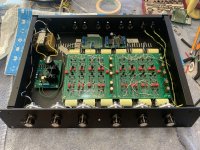
This is a three band, low pass, band pass, and high pass XO. I knew what my cutoff frequences would be for my speakers. Much appreciation for the Mike Rothacher's filter application worked like a charm. I did not use any variable resistors and only polypropolene capacitors in signal path. The fixed resistors for the filters can be removed if a change is necessary. Input attentuation is a 1db attentuation resistor ladder. Breadboarded the relay output to ground until startup delay or power decreases to a specified level. Added an emitter follower for the 12V trigger to turn on amplifiers.
Boards tested, everything is in place, just need to finish hooking up a few more things. Lots of hours in this. Should be finished tomorrow, really look forward to listening. Reading through this thread was exceptionally helpful. Thanks to the contributors and again to Nelson for providing this. So appreciative of a high end active XO.
Pardon the premature pic, will update when complete. Sooo close.

Last edited:
Another long day, but it is finished. Will put on labels tomorrow and swap out my Marchland XO and do some sweeps with Room EQ Wizard.
Thanks. I used a Studer 900 pre-assembled regulator. I think it will be fine for the application.
Thanks. I used a Studer 900 pre-assembled regulator. I think it will be fine for the application.
Attachments
- Home
- Amplifiers
- Pass Labs
- DIY biamp 6-24 crossover
